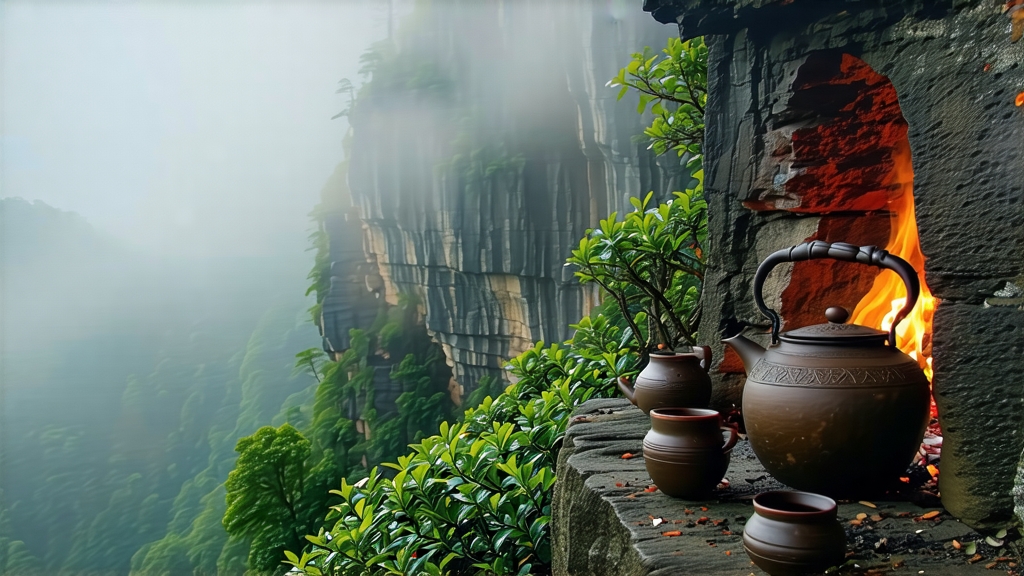
High in the mist-curtained Wuyi Mountains of northern Fujian, vertical cliffs of purple-red tuff rise above the Nine-Bend River like petrified waves. In the crevices of these “Danxia” landforms, gnarled tea bushes cling to life, their roots squeezing minerals from stone that will later translate into the celebrated “rock rhyme” of Da Hong Pao—literally “Big Red Robe.” To international drinkers the name evokes imperial scarlet, yet to Chinese tea lovers it conjures the taste of liquid granite sweetened by orchid. This essay invites you to travel from Song-dynasty legend to twenty-first-century teapot, unpacking the history, cultivars, craft, and ceremony that make Da Hong Pao the most mythologized of all oolongs.
Legend first. In the late Ming dynasty, according to local chronicles, a scholar on his way to the capital examinations fell ill near the Tianxin Temple. Monks brewed leaves picked from nearby bushes; the scholar revived, passed the exams, and returned in gratitude, draping his crimson imperial robe over the tea bushes. The emperor, impressed by the story, declared the tea a tribute item. Whether apocryphal or not, the tale secured state patronage, and by the Qing era “Yancha” (rock tea) caravans were winding north to the Forbidden City along the Mei’gu Dao plum-blossom trail.
Botanically, Da Hong Pao is not a single plant but a collective brand for several Wuyi cultivars that share a mineral terroir and processing style. The original “mother trees,” six ancient bushes perched on Jiulongke cliff, have not been harvested since 2006 to protect the genetic heritage. Today’s market offers three tiers: Qidan (pure-clone descendants of mother-tree cuttings), Beidou (cultivars selected by the Wuyi Tea Research Institute), and commercial blends that marry assorted Wuyi bushes to approximate the classical flavor. Each cultivar—Rougui for spice, Shui Xian for floral heft, Qi Lan for apricot—adds a brushstroke to the final symphony.
The crafting cycle follows the traditional “Wuyi Twelve Steps,” a choreography of wilting, bruising, oxidation, and fire that stretches across twenty-four hours. Picking occurs only in late April, when three half-mature leaves and a bud are snipped in the “open-face” standard. Sun-withering on bamboo mats lasts under an hour; the leaves are then moved indoors for alternating rounds of shaking and resting. This “green-making” bruises leaf edges, allowing enzymes to oxidize polyphenols while the leaf center stays green. When the rim turns coppery red and the aroma shifts from grass to peach, the tea is pan-fired at 220 °C for ten seconds to halt oxidation. What follows is the signature Wuyi roasting: low-temperature charcoal embers inside a mud-brick oven bake the leaf three to five times over two months. Each bake lasts six to eight hours; between bakes the tea rests in reed baskets, absorbing charcoal sweetness while losing moisture. The result is a strip-shaped leaf, glossy obsidian with a hint of mahogany, exuding aromas of toasted cacao, burnt sugar, and alpine orchid.
To unlock those aromatics, gongfu brewing is advised. A 120 ml pear-shaped Yixing teapot, seasoned only with rock oolongs, is the classic vessel. Pre-heat with boiling water, then fill one-third full of dry leaf—roughly six grams. The first infusion, a ten-second “wash,” is discarded to awaken the leaf. Subsequent steeps progress from flash infusions (five seconds) to two-minute soaks, yielding up to twelve brews. Water temperature must remain a rolling 98–100 °C to melt the leaf’s lipid-bonded aromatics. The liquor emerges the color of antique amber, edging toward deep claret by the fifth steep. On the palate, an immediate mineral snap—think wet slate after a summer storm—gives way to honeyed orchid, then a lingering cinnamon warmth that Chinese tasters call “yan yun,” the rock rhyme. The aftertaste coats the throat like cool jade, prompting salivation that can last twenty minutes.
Professional cupping uses a white porcelain gaiwan, 3 g leaf to 150 ml water, five-minute steep. Judges evaluate dry-leaf strip tightness, roast evenness, and